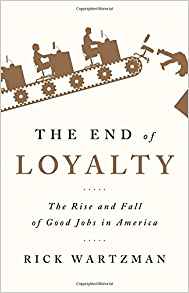You have /5 articles left.
Sign up for a free account or log in.
 The End of Loyalty: The Rise and Fall of Good Jobs in America by Rick Wartzman
The End of Loyalty: The Rise and Fall of Good Jobs in America by Rick Wartzman
Published in May 2017.
There are about 3.6 million of us who work in higher education. Of those, about 1.6 million are faculty and two million are staff. Add in about 370,000 graduate students that the government counts as higher education employees (quite rightly), and we are talking about a postsecondary labor force of close to two million.
Do you think a job in higher education is different from a job in another industry?
Is part of the reason that you chose to work in higher ed is that you do not want to work in the corporate world?
After reading Rick Wartzman’s fine new book, The End of Loyalty: The Rise and Fall of Good Jobs in America, I’ve been wondering if higher ed jobs are following a similar trajectory as corporate employment.
Wartzman’s book is not about the postsecondary labor market, but there are important lessons in the changes in corporate employer/employee relations for our industry.
The lens utilized in The End of Loyalty to make sense of the past century of corporate labor relations is that of the story of four companies: General Motors, Coca-Cola, General Electric and Kodak. Through most of the 20th century, these four companies were synonymous with big business in America. There were strongly profitable, employed hundreds of thousands of workers and through their employment practices helped grow the American middle class.
From 1948 to 1973 real wages (hourly compensation) grew by 91 percent in the U.S. This growth in wages was driven by both productivity increases at companies such as GM and GE, and by a new employment bargain that rising productivity enabled. Wartzman is careful to detail the often bitter fights that employees (and their unions) of large American companies engaged in with their employers to secure job security, higher wages and benefits. Since 1973, hourly compensation has been flat, growing only 11 percent. Almost all of these wage gains have been concentrated among more highly educated employees.
Accompanying wage stagnation since the early 1970s has been the loss of employee security. Indeed, the big story of The End of Loyalty is found in the book’s title - that is the breakdown of the social contract between employers and employees. The idea that a company owes an employee a secure job in exchange for loyalty to the corporation is today as anachronistic as all the office smoking and drinking in Mad Men.
At best, today’s corporate (and particularly technology) employers offer the idea of employability -- the idea that a good job is one where workers can develop skills that will help them get the next job. For the most educated and highly skilled employees, the employer/employee relationship resembles that of freelance work. The job stays available, and the employee stays in the job, only as long as it is in the immediate interest of both parties to continue the (temporary) relationship.
For those workers without advanced educations or skills, employment is no longer a ticket to a middle-class life, or even economic viability. Employers such as Walmart -- indeed almost all of the (shrinking) retail industry -- offer wages that are too low to disqualify a worker’s family from eligibility for the Supplemental Nutrition Assistance Program (food stamps).
The End of Loyalty is the story of how we got from the paternalistic corporation and a growing middle class to an increasingly stratified labor market, one characterized by low levels of employer/employee obligation and connection.
I’d like to bring this book review back to my original question. How do you think higher ed employment is different from corporate employment?
Is the story of the adjunctification of the faculty best understood as part of a larger trend away from long-term commitments to employees?
Should we be thinking of the growth of part-time and insecure postsecondary jobs as a story of a failure to improve higher ed productivity, just as we understand wage stagnation and insecure employment as a productivity story in the larger economy?
Alternatively, should we be trying to make sense of trends in the postsecondary labor market as analogous to impact of declining unionization rates in the corporate world, with the possible remedy coming in organization and collective action?
Are colleges and universities less likely to lay off (nontenured) employees than other industries? Where does tenure fit into the story of employment protections for the three-quarters of all teaching staff who are not tenured?
Where do staff, as well as faculty, fit into the story of employee loyalty and employer obligations?
The End of Loyalty is a good book to read to crack open the conversation about the changing higher ed social employment contract.
What are you reading?








